It’s sausage-of-the-swamp time at weedom. Cattails are showing the seed heads for which they are famous. Now it’s the best time for new foragers to locate where they can find great food for 2 to 4 seasons per year, depending on where they live and how hard it freezes in the winter.
Remember where you see the sausages, because this is the fastest way to distinguish cattails from various inedible irises, which are normally much shorter plants.

You don’t have to develop a taste for this plentiful wild food. Cattails taste great. Not the sausage, (which is better for insulation or mattress stuffing), but the lower shoots of the young plants from spring through early summer. If your area continues to produce young plants, you can continue to find edible shoots even longer. This plant also offers quality edibles from the numerous root and rhizome structures in the coolest months, as well as the pollen during the flowering season in late spring. Cattail pollen can be used to elevate the flavor of flat breads and baked goods by cutting at least 50 percent with wheat flour. Similar things can be done with dried starch from the rhizomes collected during the cooler months.
Unlike many other wild foods, it’s fairly easy to get a lot of product from the cattails without threatening their existence. In fact it’s really hard to wipe these plants out. Once you split a sausage and see the massive seed production, you’ll know why. Years ago, we scraped out the bottom of our swamp in order to increase its depth, and a full crop of cattails returned the next spring.
Our cattail crop is not as accessible as one might think by looking at it, because the swamp is beginning to dry up, as it does at the end of every normal year when the rains slow down. Interspersed with the cattails is jewelweed to the south, a few willow-bushes to the west, and poison ivy all around. Digging the rhizomes is hard work. Those who can approach cattails from a deeper side of an actual body of water can harvest the products from underground or underwater parts of the plants much more quickly and in large quantities. If you come across a floating mat or clot of cattail plants that has broken off from a marsh colony, you can flip it over and obtain a lot of good food fast, with minimal cleaning effort. At weedom, our main interest is in the central core from the lower part of the plants before they flower. It’s more accessible to us, and totally worth the effort, because it tastes like a lightly nutty flavored cucumber. It can go into tons of Asian recipies and elsewhere too. For most people it’s edible raw. For some the raw core, which forager Sam Thayer calls cossack asparagus, can leave a tingle or irritation in the mouth or throat, so they steam or stir fry it before eating. Another good reason to cook what you pull out of any wet area is less than pristine quality of the water.

It’s pretty easy to get to this lower stem portion of a young cattail. I peeled off the 2 outer layers of the stem in this picture and ate the central portion raw. After about 4 inches, I peeled off another layer and kept on munching for a few more inches. At the top of a hill, we don’t have as much water quality issues as might exist in other places. Cattails are known to efficiently take up contaminants, and are used to remediate polluted bodies of water. So consider this when choosing where you will harvest your plants.
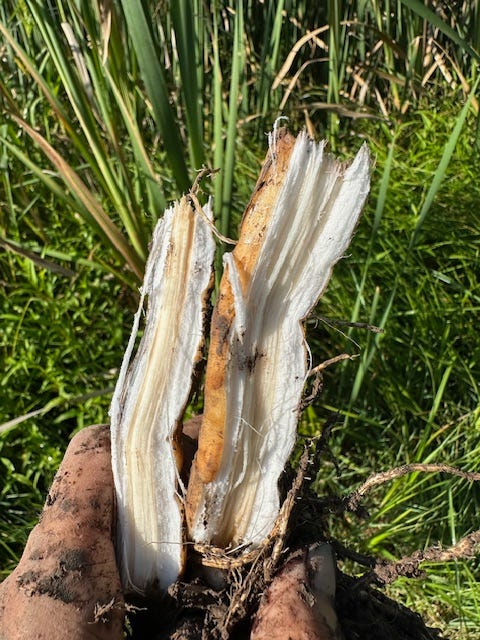
The inner yellowish core of a mature cattail rhizome is the best part. The outer layers are spongy. Rhizomes are more often harvested in cooler wetter conditions for a plumper product. But this picture gives a view of the core part that holds more starch and less fibrous material for better eating or flour production.
Four more delicacies come from the cattails which are more easily accessible to those with boats or rafts and larger crops. The first of these is the young, male flowering head of the plant before pollen is produced. The flowering stems have a wide band of female flowers below, which become the sausage when they go to seed, and a similar band of male flowers above which pollinate the lower flowers, then degenerate.
The top, male half of the flowers can be snapped off, steam cooked, and the flowers eaten like corn on the cob, or stripped and used as topping, stuffing, etc. Do this while it’s still green looking, before you see any yellowing or pollen production.
As mentioned above, once the male portion turns yellow, produces copious pollen. At this stage, the male flowers can be stripped off and sifted to leave blooms and fiber and bugs in the strainer, and the fine powdery pollen collected in a bowl below. It’s easier to do that outside if you don’t want a house and nose full of yellow dust. Some people want to shake the male flowers into a bag. This is a frustrating and less efficient way to go, since a lot of pollen is needed to make any useful quantity of food. In addition to its flour extending utility, this product of the plant is about 17% protein, and contains numerous medicinal constituents recognized most particularly in Traditional Chinese Medicine.
If you pull up a whole cattail from the muck, young rhizomes with pointy ends, which are called laterals, can be eaten as the top-rated delicacy coming from this plant. These parts so good that people will get down into the muddy marsh bottoms and feel around for them directly, or harvest the whole plants to remove the rhizome tips. They are perfect raw or cooked, or marinated. A mature rhizome develops quite a bit of fiber in its structure from which starch has to be extracted. It’s no longer a delicacy, though still a great source of starch and minerals. Whether cooked or not, the starch is chewed out of the central core of the rhizome, and the fiber must be spat out.
Lastly there is a highly technical acronym, SLOTSM 😎 for the part of the root ball that’s just underneath the shoot of a cattail plant. It stands for “sizable lump of tender starchy material”, which is what Euell Gibbons called another particularly palatable portion of the cattail plant that could be directly eaten raw, or cooked. This part of the plant discolors somewhat if not cooked quickly and thoroughly. The SLOTSM is reached by trimming all the roots and rhizomes off of the lower part of the plant below the shoot. It might be as small in diameter as your little finger, or maybe up to an inch and a half. If you’ve yanked up a whole cattail shoot by the roots, you might as well go for the gusto and carve out this part. Again, the roots and rhizomes are cooler weather accessible, from fall to mid spring. The stage of the plant’s growth is more pertinant to the quality of eating than time of year, with the lower parts of the plant being best, and most of them truly pleasant eating, prior to the time of flowering.
Cattails, of the genus Typha, belong to the family Typhaceae, which contains only one other genus, Sparganium, the bur-reeds which are also edible. Within the cattail genus are 10-15 species depending on who one believes. Cattails are easy to identify with confidence, particularly because the remains, including the seed sausage of the plants remain recognizable long after the flowering, and often into subsequent seasons. The unique character of the sword-like leaves also aid in distinguishing the cattail species from other inedible plants of the swamp.
The leaves extend from the rounded base of the plant in a continuous erect fashion, and they remain tightly associated with each other up to a height of 2 or more feet from the ground. There is no midrib, no hairs, and the leaf margins are smooth and entire. Potential lookalike plants such as Calamus acorus, sweet flag, are much shorter, with flowers extending from the sides of the leaves about halfway up. The leaves of the various irises grow out of a flattened, not round base, in a much more angular fashion.
Fortunately the most widely distributed cattails are similarly useful and edible, although Typha latifolia, the common cattail, is the largest and most rewarding food producer. This plant grows in any marshy area in continental North America with the exception of places that stay frozen all year. Cattails are widely distributed worldwide, so that most people who read weedom have seen these weeds somewhere. The smaller Typha angustifolia, narrow leaf cattail, is similarly well distributed, but prefers less submerged areas, so more work is often involved in collecting the underground parts. These two species frequently hybridize. One other way to distinguish these plants, besides the narrower, perhaps half inch wide leaves on the T. angustifolia, is that this plant shows a naked band of stem between the male and female flowering parts.
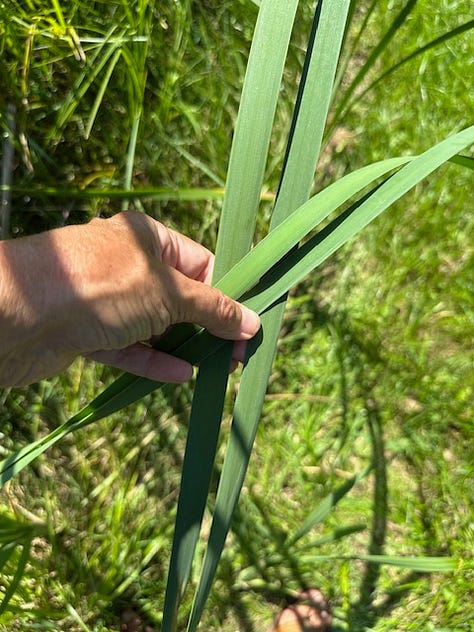
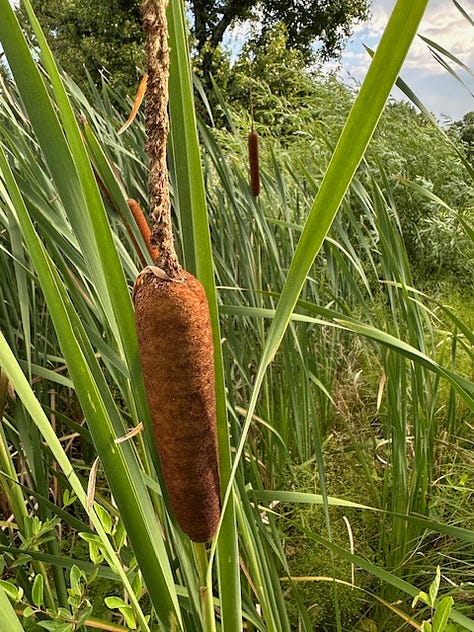
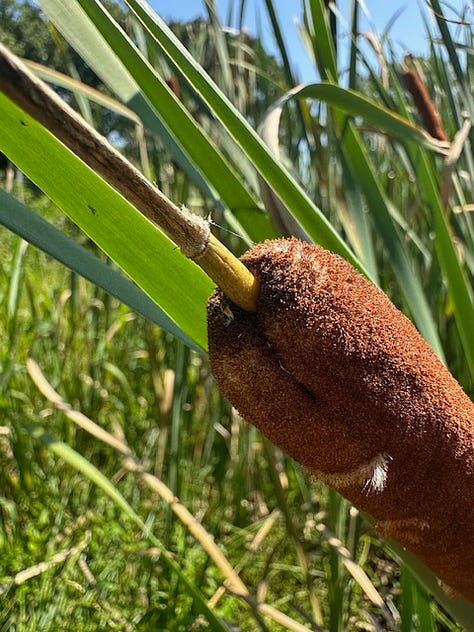
Common cattail may reach up to 10 feet in height, with leaves up to an inch and a half wide. The narrow leaf cattail runs a few feet shorter in height, with correspondingly narrower leaves with somewhat pointier tips. And these species hybridize, so that the swamp sausage crop of weedom is quite a mix. Below is a sausage cracked in half. The seeds aren’t quite mature yet, but you can see that there’s enough to populate many swamps. For germination these plants need exposed soil that’s not covered by water. Cattails are able propagate extremely efficiently by means of rhizomes, should the waters never subside.
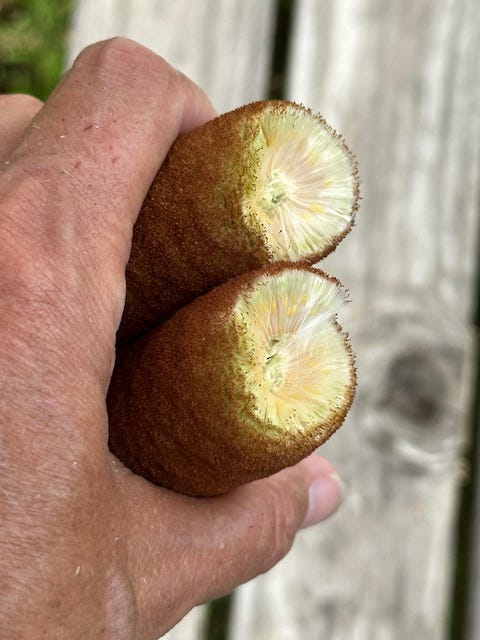

In the warmer regions of the U.S. is Typha domingensis the Southern cattail, which inhabits temperate to tropical regions, and has similar food and medicinal uses to the two species above. It is perhaps more well studied by our pharmacognosy friends in the Middle East and Asia. This plant like the other 2 major species can be considered a world wide native plant. It grows up to 12 feet in height, and like T. angustifolia can have a band of separation between the male and female flowers. Like the other 2 major species, it hybridizes readily, creating continuous confusion among the botanists.
One of the most interesting recipes for cattail pollen comes from Iraq. It’s a confection, called khirret or boori combining sugar and the pollen, which is then steamed in cloth bags until it looks like a yellow brick, then broken into smaller pieces and served or sold as a healthy snack. People eat it to relieve indigestion or diarrhea. Due to the cattail pollen ingredient, khirret is believed to be generally good for the colon, the respiratory tract and the urinary tract. Nawal Nasrallah writes about this rare and healthier than normal candy in her blog “My Iraqi Kitchen” but without giving the precise proportions of pollen to sugar. So the forager chef, Alan Bergo went to work on this recipe and established a viable method of production. He used 15 grams (1/4 cup) of pollen, 90 grams (1/2 cup) of turbinado sugar, finely ground, to which he added 15 grams or 1 tablespoon of cooked, riced potato. He steamed this mixture in a muslin cloth bag in a closed container for an hour producing a palatable confection. His alternative method was to place the mixture in a vacuum sealed bag and cook at 180 degrees for 2 hours.
There’s quite a bit more news you can use about cattails uses around the world, which will continue in another post. Hopefully our readers be inspired to dig some rhizomes this fall, and harvest a considerable quantity of shoots in spring, and later some pollen. Meanwhile, after your cattails have begun to go to seed, consider some crafting uses. The leaves are an easy and accessible material to use for basketweaving 101.
Have you been lost in the cattails already? Tell us what you’ve discovered. 👍🏼
Where We Dig
1. Bergo A. Foraging and Cooking Cattails. Forager | Chef. June 21, 2025. Accessed August 12, 2025. https://foragerchef.com/edible-cattails/
2. Jordan D. Eat the Weeds: A Forager’s Guide to Identifying and Harvesting 274 Wild Foods. Adventure Publications; 2023.
3. Keswani A. B^oori~Boorani Mitti |. May 21, 2017. Accessed August 12, 2025. https://sindhirasoi.com/2017/05/booriboorani-mitti/
4. Sharp JEM. The problem with cattails. Hoosier Gardener. September 16, 2017. Accessed August 11, 2025. https://hoosiergardener.com/12503/
5. Thayer S. The Forager’s Harvest - A Guide to Identifying, Harvesting, and Preparing Edible Wild Plants. Forager’s Harvest Press; 2006. https://openlibrary.org/books/OL8588402M/The_Forager's_Harvest
6. Thayer S. Sam Thayer’s Field Guide to Edible Wild Plants of Eastern & Central North America. Forager’s Harvest; 2023.
7. Zhou B, Tu T, Kong F, Wen J, Xu X. Revised phylogeny and historical biogeography of the cosmopolitan aquatic plant genus Typha (Typhaceae). Sci Rep. 2018;8(1):8813. doi:10.1038/s41598-018-27279-3
8. Cattail. White Rabbit Institute of Healing. Accessed August 12, 2025. https://www.whiterabbitinstituteofhealing.com/herbs/cattail/
9. Cattail pollen - Dr. Christopher Hobbs, Ph.D. Accessed August 12, 2025. https://christopherhobbs.com/herbal-therapeutics-database/herb/cattail-pollen/
10. Cattails - Narrowleaf and Hybrid. WNY PRISM. Accessed August 11, 2025. https://www.wnyprism.org/invasive_species/cattails-narrowleaf-and-hybrid/
11. In my Iraqi Kitchen: Recipes, History and Culture, by Nawal Nasrallah. Accessed August 12, 2025. https://nawalcooking.blogspot.com/2013/03/khirret-cattailtypha-pollen-gift-of.html
12. Typha latifolia (Broadleaf Cattail, Bulrush, Cat-O’-Nine-Tails, Common Cattail) | North Carolina Extension Gardener Plant Toolbox. Accessed August 11, 2025. https://plants.ces.ncsu.edu/plants/typha-latifolia/
13. Southern Cattail. Nature Collective. April 16, 2019. Accessed August 12, 2025. https://naturecollective.org/plant-guide/details/southern-cattail/



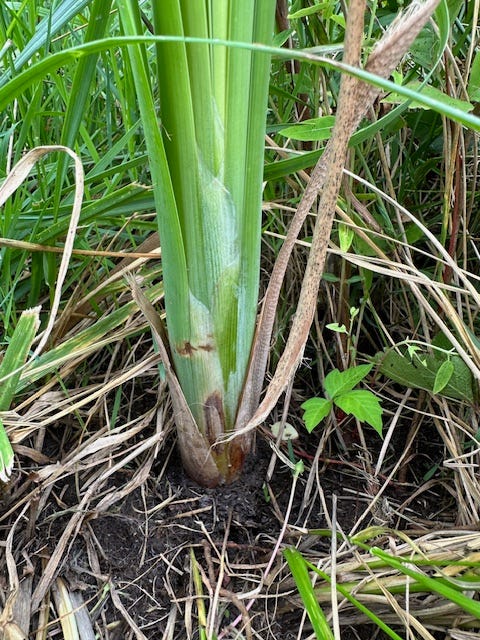
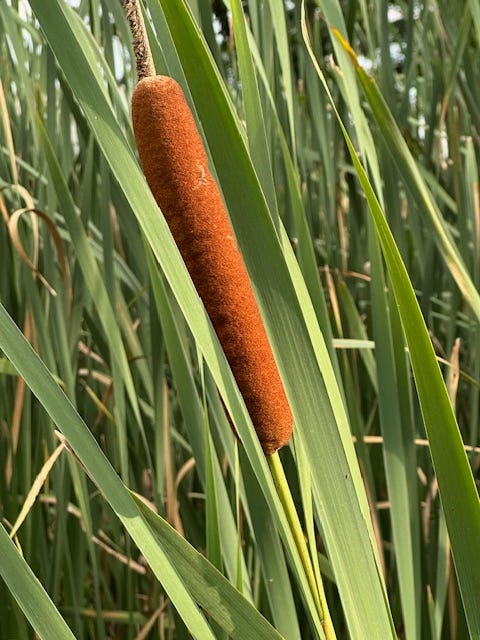

Excellent. Good post with lots of practical details for harvest.
Question: do you have a disclaimer due to experience or legal advice or just out of concern for readers? I have thought about including one when writing about mushrooms and foraging...